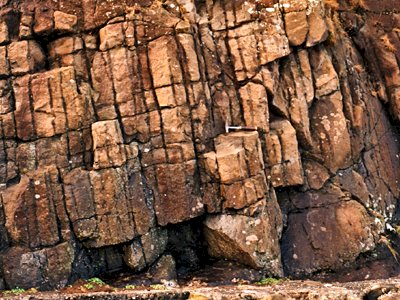Earth Science Conservation Review
| Black Head, Island Magee | Antrim |

| Site Type: | Cliff |
| Site Status: | ESCR |
| Council area: | Carrickfergus Borough Council |
| Grid Reference: | J489935 |
| Google maps: | 54.76776,-5.68641 |
| Rocks | |
|---|---|
| Rock Age: | Tertiary (Eocene, Palaeocene) |
| Rock Name: | Antrim Lava Group, Lower Basalt Formation |
| Rock Type: | Basalt |
| Interest | |
| Other interest: | pipe amygdaloid, pipe vesicle, Extrusion |
Summary of site:
This site is famous for the development of vesicle cylinders in a lava flow. These structures take the form of pipes, 2-3cm in diameter and about 2m long; at this locality they are spaced at intervals of between 10 and 20cm and form a striking array in the cliff face. They are roughly perpendicular to the base of the lava flow.
They are thought to have been caused by a persistent injection of volatiles at the base of a static but still molten lava flow. Several scenarios are proposed for their formation, from the trapping of air beneath an advancing flow to the absorption of gases and vapours from damp ground below the static ponded lava. The volatiles would create a slightly less dense lava, with a tendency to migrate upwards in ‘tubes' spaced at fairly regular intervals. As the lava in each tube cooled, it would convert to gas creating the cylinders.
The walls of the cylinders are coated with minerals, usually belonging to the zeolite group, that could have crystallised either as the cylinders formed or from rich solutions circulating in groundwater sometime later.
Vesicle cylinders differ from pipe amygdales in their method of formation, the latter being caused by a steady stream of volatiles degassing from a mobile flow.
Although isolated examples of vesicle cylinders exist elsewhere in Northern Ireland, this locality with its extensive array is by far the best currently known. In a UK context, it is particularly important since Northern Ireland has the largest developments of basalts and their related phenomena.
The proximity of this locality to a well used footpath presents particular conservation problems and path works could easily destroy it completely. All hammering should be banned and any sampling for research should be conducted elsewhere. A conservation management plan for this site presents something of a challenge.
They are thought to have been caused by a persistent injection of volatiles at the base of a static but still molten lava flow. Several scenarios are proposed for their formation, from the trapping of air beneath an advancing flow to the absorption of gases and vapours from damp ground below the static ponded lava. The volatiles would create a slightly less dense lava, with a tendency to migrate upwards in ‘tubes' spaced at fairly regular intervals. As the lava in each tube cooled, it would convert to gas creating the cylinders.
The walls of the cylinders are coated with minerals, usually belonging to the zeolite group, that could have crystallised either as the cylinders formed or from rich solutions circulating in groundwater sometime later.
Vesicle cylinders differ from pipe amygdales in their method of formation, the latter being caused by a steady stream of volatiles degassing from a mobile flow.
Although isolated examples of vesicle cylinders exist elsewhere in Northern Ireland, this locality with its extensive array is by far the best currently known. In a UK context, it is particularly important since Northern Ireland has the largest developments of basalts and their related phenomena.
The proximity of this locality to a well used footpath presents particular conservation problems and path works could easily destroy it completely. All hammering should be banned and any sampling for research should be conducted elsewhere. A conservation management plan for this site presents something of a challenge.
| Enlander, I., Dempster, M. & Doughty, P., 2025. Black Head, Island Magee, County Antrim, site summary. [In] Earth Science Conservation Review. https://www.habitas.org.uk/escr/summary.php?item=1075. Accessed on 2025-04-03 |
| Previous Site | Next Site |

